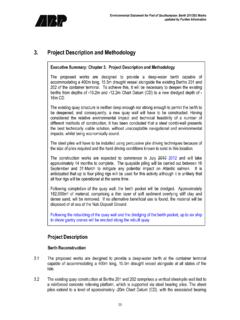Transcription of Part I Section 263.–Capital Expenditures
1 part ISection 263. capital Expenditures26 CFR (a)-1: capital Expenditures ; in general.(Also 162, 165, 167, 263A; , (a)-8, (a)-11, )Rev. Rul. 2000-7 ISSUEIf the retirement and removal of a depreciable asset occurs in connection withthe installation or production of a replacement asset, are the costs incurred in removingthe retired asset required to be capitalized under 263(a) or 263A as part of the cost ofthe replacement asset?FACTSThe assets of X, a telephone company, include telephone poles A and B. Xplaced Pole A in service in 1979 on land it owned. X placed Pole B in service in 1982on land owned by Y under the terms of an easement permitting X to have one pole onY's land. In 2000, X undertakes a project to replace telephone poles in the servicearea in which Pole A is situated. As part of that project, X incurs costs in 2000 inremoving and discarding Pole A and installing a new telephone pole, Pole C, in thesame location.
2 X also undertakes a second project to replace telephone poles in theservice area in which Pole B is situated. X installs a new telephone pole, Pole D, onY's land, but not in the same location as Pole B. As part of this second project and tocomply with the easement, X incurs costs in 2000 in removing and discarding Pole B. -2-LAW AND ANALYSISS ection 162 of the Internal Revenue Code and of the Income TaxRegulations generally allow a deduction for all the ordinary and necessary expensespaid or incurred during the taxable year in carrying on any trade or 165 allows as a deduction any loss sustained during the taxable yearand not compensated for by insurance or otherwise. For the allowance under 165(a)of losses arising from the permanent withdrawal of depreciable property from use in atrade or business or in the production of income, (c) cross references (a)-8(a), which permits, in part , a loss from physical abandonment of retiredproperty.
3 Under 263(a) and (a)-1(a), no deduction is allowed for capitalexpenditures, such as amounts paid for new buildings or for permanent improvementsor betterments made to increase the value of any property. Section (a)-2(a)provides that capital Expenditures include the costs of acquisition, construction, orerection of buildings, machinery and equipment, furniture and fixtures, and similarproperty having a useful life substantially beyond the taxable 263A generally requires taxpayers that are producing real or tangiblepersonal property to capitalize direct material costs, direct labor costs, and indirectcosts that are properly allocable to the produced property. Section 263A(g)(1)provides that, for purposes of 263A, the term produce includes construct, build,install, manufacture, develop, or improve. Under (e)(3)(i), indirect costs are-3-allocable to produced property under 263A when the costs directly benefit or areincurred by reason of the performance of production costs of removing an asset have been historically allocable to the removedasset and, thus, generally deductible when the asset is retired and the costs areincurred.
4 A deduction generally is allowed whether a taxpayer accounts for the retiredasset in a single asset account or in a multiple asset account ( , a general assetaccount or a mass asset account). See (b); (a)-1(c); (a)-11(d)(3)(x); Rev. Rul. 74-455, 1974-2 63; Rev. Rul. 75-150, 1975-1 73. Butsee 280B, requiring that the costs of demolishing buildings be added to the basis ofthe land, and (a), requiring capitalization of demolition costs when thetaxpayer acquires an asset with the intent to demolish it. See, , Wood CountyTelephone Co. v. Commissioner, 51 72 (1968); Rev. Rul. 69-62, 1969-1 removal costs of Poles A and B are not required to be capitalized under 263(a). In both situations the removal costs are properly allocable to the retiredpoles, and thus do not relate to assets having a useful life in the taxpayer s businessextending substantially beyond the taxable year in which the removal costs areincurred.
5 The fact that Poles A and B are retired as part of a replacement project doesnot mean that the removal costs are required to be capitalized under 263(a). Furthermore, the removal costs are not required to be capitalized under 263 Abecause the costs are incurred for the purpose of retiring Poles A and B and not byreason of the installation of Poles C and D. The analysis in this ruling does not apply-4-to the removal of a component of a depreciable asset, the costs of which are eitherdeductible or capitalizable based on whether replacement of the component constitutesa repair or an improvement. See and (a)-1(b).HOLDINGIf the retirement and removal of a depreciable asset occurs in connection withthe installation or production of a replacement asset, the costs incurred in removing theretired asset are not required to be capitalized under 263(a) or 263A as part of thecost of the replacement change in a taxpayer s method of accounting to conform with this revenueruling is a change in method of accounting to which the provisions of 446 and 481and the regulations thereunder apply.
6 Except for assets for which depreciation isdetermined in accordance with (a)-11 (ADR), the taxpayer s new method oftreating removal costs for assets accounted for in a multiple asset account must beconsistent with the taxpayer s method of treating salvage proceeds. See Rev. Rul. 74-455. (See sections and of the Appendix of Rev. Proc. 99-49, 1999-52 , for changing a taxpayer s present method of treating salvage proceeds.) Ataxpayer wanting to change its method of accounting to conform with the holding in thisrevenue ruling must follow the automatic change in accounting method provisions ofRev. Proc. 99-49, except that the scope limitations in Section of Rev. Proc. 99-49do not apply. However, if the taxpayer is under examination, before an appeals office,-5-or before a federal court with respect to any income tax issue, the taxpayer mustprovide a copy of the Form 3115, Application for Change in Accounting Method, to theexamining agent(s), appeals officer, or counsel for the government, as appropriate, atthe same time that it files the copy of the Form 3115 with the national office.
7 The Form3115 must contain the name(s) and telephone number(s) of the examining agent(s),appeals officer, or counsel for the government, as appropriate. In addition, if the assetis public utility property within the meaning of 168(i)(10) or former 167(l)(3)(A), thetaxpayer must comply with the terms and conditions in Section (3)(b)(vi) of theAppendix of Rev. Proc. ON OTHER DOCUMENTSRev. Proc. 99-49 is modified and amplified to include this change in accountingmethod in the INFORMATIONThe principal author of this revenue ruling is Beverly Katz of the Office ofAssistant Chief Counsel (Income Tax and Accounting). For further informationregarding this revenue ruling contact Ms. Katz on (202) 622-4950 (not a toll-free call).














